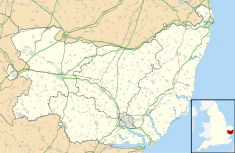|
Lavenham Guildhall
Lavenham Guildhall is a timber-framed municipal building in Lavenham, Suffolk, England. It is Grade I listed.[1] HistoryBy the late 14th century, Lavenham was at the centre of the East Anglian woollen cloth trade.[2] Its specialised production of woad-dyed broadcloth, known as Lavenham Blue,[3] had made it one of the richest towns in England.[a] This wealth was the catalyst for four guilds being established in the town by the local merchant families: the most important of these was the Guild of Corpus Christi formed in 1529.[9] The guild established their guildhall at around that time; the design made extensive use of jettied timber framing and featured a gabled porch projecting from the centre of the building on the north-west elevation.[1] With the decline of the woollen cloth trade and Lavenham's prosperity, the guildhall's role changed. By 1689, the guildhall was in use as a bridewell, and from 1787 it was used as a workhouse.[1] Prison cells and mortuary buildings were established in the area behind the guildhall in 1833.[7] In 1887, the guildhall was acquired by Sir Cuthbert Quilter, a local member of parliament. He soon started restoring the building, but this was only completed in around 1911.[1] The building was used as a social club for American troops stationed nearby[10] and also as a British Restaurant during the Second World War and, in 1946, Sir William Quilter gave it to the people of Lavenham.[2] It became the property of the National Trust in 1951 and it was subsequently opened to the public as a local history museum.[11][12] Inside the guildhall, in addition to exhibits presenting the evolution of the guildhall from cloth trade to workhouse, there is a display of memorabilia associated with Lavenham railway station, which was a stop on the Long Melford–Bury St Edmunds branch line before it closed in 1961.[7] NotesReferences
External links
|
||||||||||||||||||||||
Portal di Ensiklopedia Dunia

